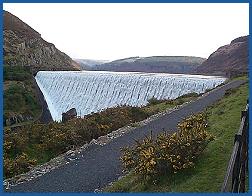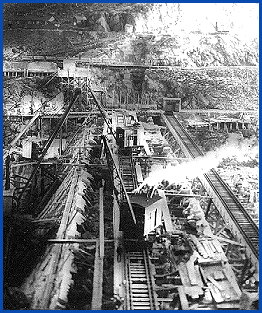
The Elan Valley dams
Caban Coch dam
Caban Coch
dam in full flow,
May, 2000
The first of the dams
The lowest of the dams in the sequence of four built in the valley
of the Elan River is Caban Coch dam. It is the simplest and most
functional  in appearance of all the dams,
resembling a natural waterfall when the reservoir is full and
the dam is in full spate with water pouring over the dam wall.
in appearance of all the dams,
resembling a natural waterfall when the reservoir is full and
the dam is in full spate with water pouring over the dam wall.
Eustace Tickell, one of the senior engineers on the waterworks scheme, wrote of this dam before it was completed "..in time of flood, when the storm water rushes over the crest and falls to a depth of over 120 feet, the dam at Caban Coch will present the appearance of a magnificent waterfall".
The location of
the Elan Valley dams
and reservoirs
is shown on the
sketch map.
The Caban Coch dam contributes to the supply of water to Birmingham
when water levels are normal, but it also provides compensation
water to ensure that adequate flow is maintained in the Elan
and the Wye downstream from the dams. (See the cross-section
of the Elan Valley dams on another page.) The  Elan
joins the River Wye at Rhayader. The 1892 Act of Parliament which
allowed the water scheme to go ahead set minimum levels of compensation
water to be released into the river, with financial penalties
if these were not maintained.
Elan
joins the River Wye at Rhayader. The 1892 Act of Parliament which
allowed the water scheme to go ahead set minimum levels of compensation
water to be released into the river, with financial penalties
if these were not maintained.
There are identical stone buildings on either side of the river just below the dam wall which house electricity generating turbines and valves and sluices to adjust the amount of compensation water released downstream. These can be seen in the 1908 photograph on the right.
Caban Coch dam
construction
from an early
glass slide of 1901
Powys
County Archives
 The start of construction work
on the individual dams was determined by the rate of progress
in the building of the railway system.
This was needed to transport the huge quantities of materials
to site of each dam, and the line to Caban Coch, the nearest
to Rhayader, was the first section to be operational, in May
1894.
The start of construction work
on the individual dams was determined by the rate of progress
in the building of the railway system.
This was needed to transport the huge quantities of materials
to site of each dam, and the line to Caban Coch, the nearest
to Rhayader, was the first section to be operational, in May
1894.The digging and blasting of the foundations for the dam started in August 1894, and work on the masonry structure of the dam itself began in 1896.
The 1901 image (left) shows the huge steam cranes in use, railway tracks at many levels, and a track cantilevered out from the dam wall on the right. The figure standing below the nearest crane gives an idea of the scale of these early machines.